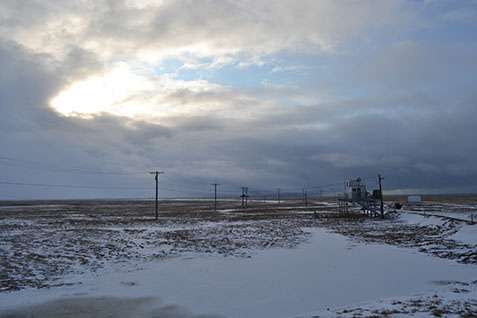Unraveling the mysteries of Arctic clouds

Clouds play a role in warming the Arctic and coinciding decreases in sea ice, but it is a complicated story. Using data from three Arctic sites, scientists studied the relationships among temperature, water vapor, and how clouds insulate the Earth. They found that in polar regions, clouds don't behave as they do elsewhere. In the Arctic, the insulating value of clouds stays the same as long as the relative humidity doesn't vary. This stability is disrupted if relative humidity varies.
These findings explain why observed seasonal and regional variability in the insulating behavior of Arctic clouds do not display the same relationships as seen in the midlatitudes and tropics. The results have important implications for future changes in how clouds both insulate and cool the planet. Reductions in the amount of sea ice in the Arctic will lead to more areas of open water in the Arctic and, through a chain of events, an increase in the insulating ability of clouds in the fall. These findings illustrate the importance of understanding how temperature and humidity may change together in the future to predict how cloud impacts may vary with climate change.
Using observational data, scientists derived three-hour averages of surface infrared cloud radiative effect (CRE; a measure of cloud insulating properties) at stations representative of different Arctic regions—Barrow, Alaska; Eureka, Canada; and Summit, Greenland. The amount of water vapor in the atmosphere at these locations spanned a large range from less than 0.1 cm in winter at Summit to ~2 cm in summer at Barrow. Over the range of Arctic conditions, CRE in the mid-infrared wavelength region increases with temperature and water vapor while CRE in the far-infrared wavelength region decreases. When summed, the compensation of these two spectral regions hides the dependence on temperature and humidity between ~230 and 280 K, and, thus, explains the lack of correlation in CRE shown in the observations. These compensating flux variations are unique to the temperature and humidity ranges observed in the Arctic.
To investigate this compensation in more detail, scientists performed radiative transfer calculations using profiles of temperature and water vapor observed at Barrow and Summit. Owing to the compensating effect described previously, temporal or spatial variations in temperature and water vapor within the Arctic temperature range do not change CRE as long as the relative humidity stays constant. Relative humidity, a quantity we are all familiar with from weather forecasts, depends on both the amount of water vapor in the air and the temperature. The same amount of water vapor at a colder temperature would give a higher relative humidity. The scientists found that if only water vapor or temperature changed, the CRE or insulating effect of Arctic clouds would change. However, if both the water vapor and temperature changed in a way to keep the relative humidity constant, then the CRE stayed constant.
To understand the potential impacts of these findings, scientists used a climate model to project future changes in the Arctic system. The model showed that increases in the cloud-insulating factor began in the early 2000s, with the largest changes projected to appear after 2040 in autumn. This result is associated with temperature increases in autumn outpacing the expected water vapor increases, leading to a reduction in relative humidity. A similar but smaller signal is observed in spring, in part because of less cloud cover and generally thinner clouds during that season.
More information: Christopher J. Cox et al. Humidity trends imply increased sensitivity to clouds in a warming Arctic, Nature Communications (2015). DOI: 10.1038/ncomms10117
Journal information: Nature Communications
Provided by US Department of Energy


















